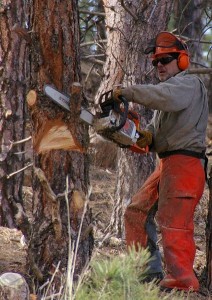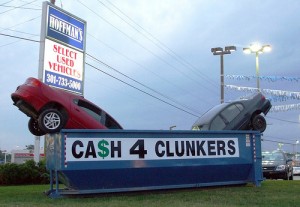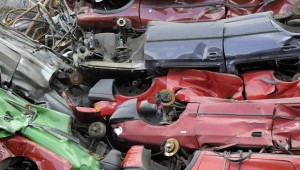For a symbol of environmental mojo, you can’t do any better than trees. After all, have you ever heard an environmentalist called a seal hugger? A snail darter hugger? Nope, it’s tree hugger. Among environmental icons, bark and leaves trump fur and scales every time.
 So to say that burning a tree equals the environmental benefits of hugging one strikes the average observer as fairly absurd. Until recently, you could have counted me among those average observers. When I started reading about wood biomass as a power and heating source, my first thoughts were that we’d strip the country of forest even faster than we are now, and that burning anything for energy is a bad idea. How one book can change your outlook …
So to say that burning a tree equals the environmental benefits of hugging one strikes the average observer as fairly absurd. Until recently, you could have counted me among those average observers. When I started reading about wood biomass as a power and heating source, my first thoughts were that we’d strip the country of forest even faster than we are now, and that burning anything for energy is a bad idea. How one book can change your outlook …
In my case, the book is by New Hampshire writer, world-class skeptic and varsity wiseass Jack McEnany. To appreciate what I’m about to say, you have to know that McEnany is about as far from an apologist for American industry as you can get and still qualify as American. His cred as a contrarian includes writing for The Nation and founding the Web site NewHampshirePrimary.com to counterbalance the conservative Manchester newspaper and television station. So when Jack says burning a tree for energy does no net harm to the environment,I pay attention, and you might want to also.
To write his book Brush Cat,On Trees, The Wood Economy, And The Most Dangerous Job In America, McEnany spent months traipsing around with the independent loggers who harvest timber lots in New Hampshire’s stretch of the Great Northern Forest. Along the way, he learned the environmental and economic wisdom in selectively harvesting trees, which often amounts to culling out trees that hinder the forest’s growth. That’s a radically different approach than mass clear-cutting, which takes all of the timber from an area no matter how low or high quality it is.
 The most important point McEnany makes comes in a chapter titled “Climate Change and The Forest,” where he lays out the environmental math around wood as a biomass fuel. Basically, McEnany says, nature is self-regulating. When a tree burns, the environment re-absorbs the resulting carbon dioxide and turns it into plants, trees, and, eventually, us. There is no pollution other than wood ash, because at the end of the process, the burned tree creates no surplus carbon dioxide. Burning doesn’t turn into a problem until it adds extra carbon into the environment. Oil and coal, which provide most of our heat and electricity, are extra carbon.
The most important point McEnany makes comes in a chapter titled “Climate Change and The Forest,” where he lays out the environmental math around wood as a biomass fuel. Basically, McEnany says, nature is self-regulating. When a tree burns, the environment re-absorbs the resulting carbon dioxide and turns it into plants, trees, and, eventually, us. There is no pollution other than wood ash, because at the end of the process, the burned tree creates no surplus carbon dioxide. Burning doesn’t turn into a problem until it adds extra carbon into the environment. Oil and coal, which provide most of our heat and electricity, are extra carbon.
Oil and coal are carbon plant matter that nature has retired by burying it under several million years worth of earth and rock. It’s out of circulation and, as long as it stays in the ground, no environmental threat. But when we bring it to the surface and burn it, we’re adding more carbon dioxide to the environment than it can recycle. So burning isn’t the problem per se. Nature burns every time a lightning bolt hits a dry forest. It’s that we’re burning carbon that has been out of circulation eons longer than even the street directory for Atlantis.
The other issue with using wood as a fuel source is the potential to depilate the landscape. McEnany makes a strong case that a well-managed forest as large  as the Great Northern Forest can thrive as a fuel source without decimating the old-growth forest that environmentalists treasure. Forests need to be thinned out for their health. If brush cats don’t do it with chain saws, nature will do it with lightning bolts. The policy of “sequestering” specific tracts of forest promotes good management. Sequestering preserves forest lots from extensive cutting, which gives them time to sustain themselves over the long term.
as the Great Northern Forest can thrive as a fuel source without decimating the old-growth forest that environmentalists treasure. Forests need to be thinned out for their health. If brush cats don’t do it with chain saws, nature will do it with lightning bolts. The policy of “sequestering” specific tracts of forest promotes good management. Sequestering preserves forest lots from extensive cutting, which gives them time to sustain themselves over the long term.
At the same time that he makes a case for wood as a fuel source, however, McEnany offers this caution:
“How will we ensure that the growing demand for wood chips won’t result in unsustainable forestry practices? A truckload of chips is the same whether it comes from a wide swath of saplings (pecker poles) or a dense thicket of balsams ready to be harvested.
The forest needs a seat at the table when public policy decisions affecting climate change are made. With the right mix of official policies and personal choices, we can fix the environment and save the forest.”




